Interpreting UNCLOS Article 33 for South China Sea Protection
VerifiedAdded on 2022/08/25
|31
|10254
|287
Report
AI Summary
This report examines the potential of Article 33 of the United Nations Convention on the Law of the Sea (UNCLOS) to establish environmental protection in the South China Sea. The research investigates whether Article 33 can be newly interpreted to grant jurisdiction over the contiguous zones for environmental protection, considering the specific context of the South China Sea and the claims of China, Taiwan, and Vietnam. The report compares the Exclusive Economic Zone (EEZ) and the contiguous zone regarding their abilities to safeguard the marine environment. It analyzes the legal framework of the contiguous zone, including authority and jurisdiction, and explores how Article 33 could be used to enact environmental protection laws, considering the existing challenges like overfishing and pollution. The study also reviews the background of the South China Sea, highlighting its strategic importance, rich resources, and territorial disputes, particularly focusing on the impact of human activities like fishing on marine ecosystems and the role of ASEAN in addressing these issues. The report aims to determine the potential of Article 33 for environmental protection in the South China Sea.
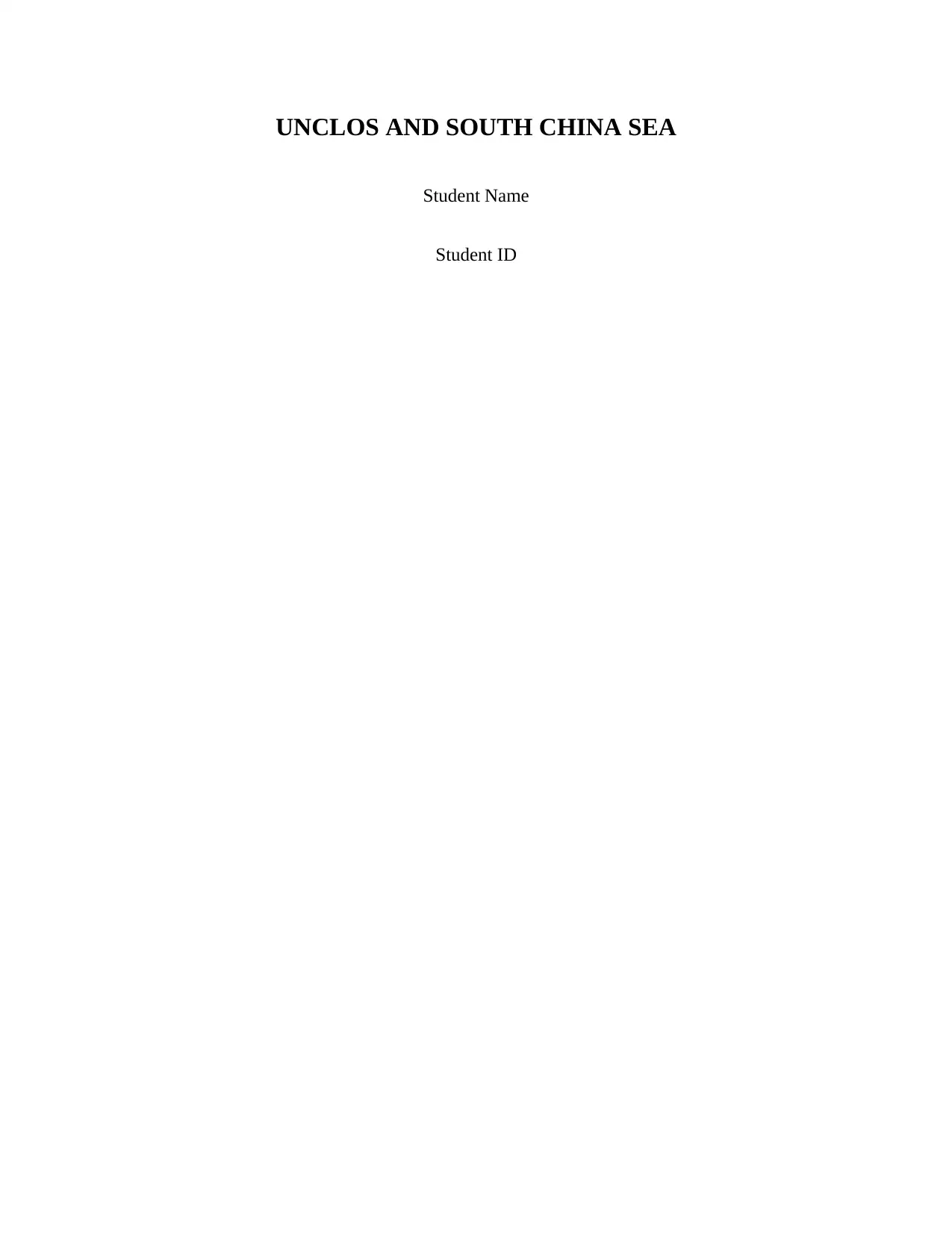
UNCLOS AND SOUTH CHINA SEA
Student Name
Student ID
Student Name
Student ID
Paraphrase This Document
Need a fresh take? Get an instant paraphrase of this document with our AI Paraphraser
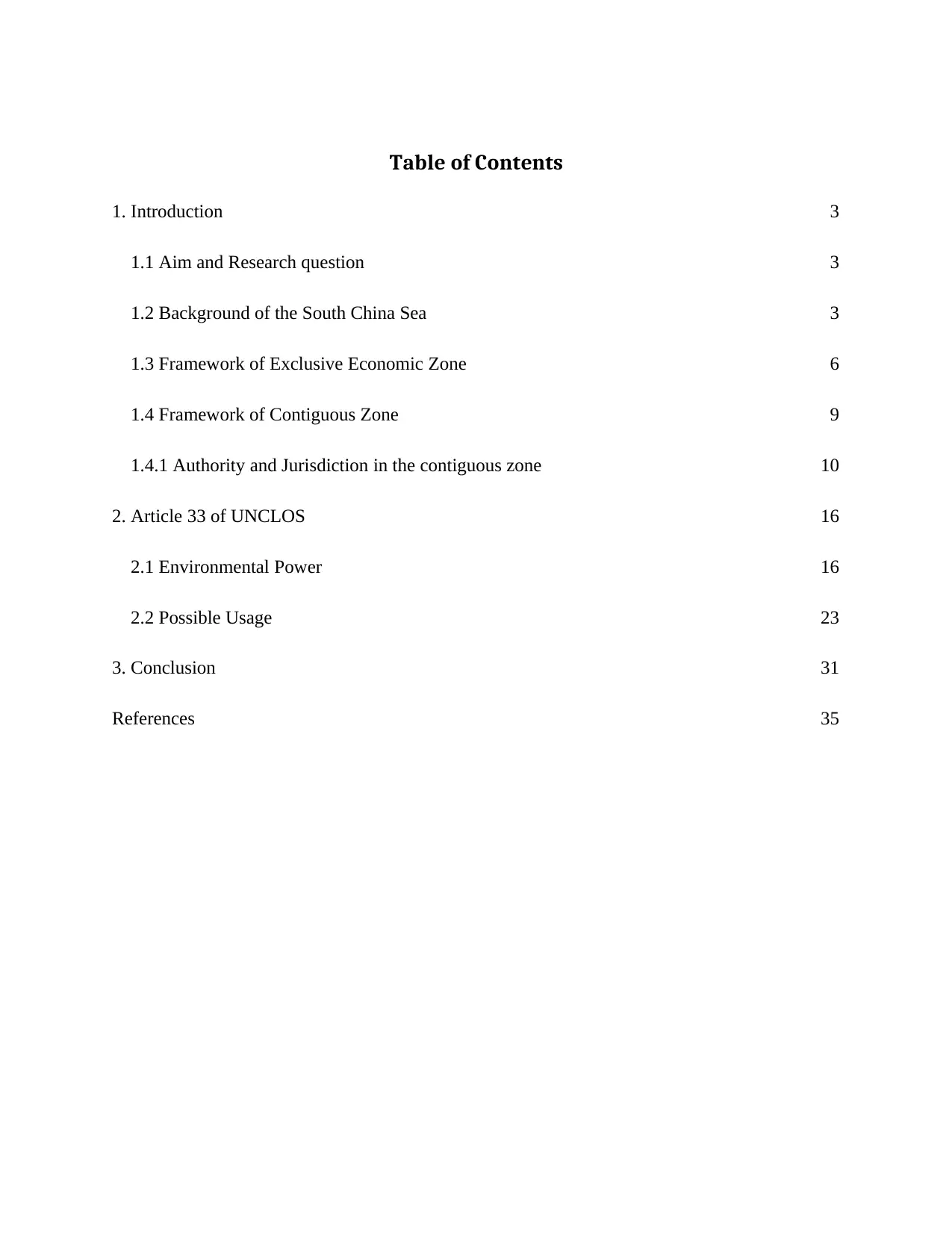
Table of Contents
1. Introduction 3
1.1 Aim and Research question 3
1.2 Background of the South China Sea 3
1.3 Framework of Exclusive Economic Zone 6
1.4 Framework of Contiguous Zone 9
1.4.1 Authority and Jurisdiction in the contiguous zone 10
2. Article 33 of UNCLOS 16
2.1 Environmental Power 16
2.2 Possible Usage 23
3. Conclusion 31
References 35
1. Introduction 3
1.1 Aim and Research question 3
1.2 Background of the South China Sea 3
1.3 Framework of Exclusive Economic Zone 6
1.4 Framework of Contiguous Zone 9
1.4.1 Authority and Jurisdiction in the contiguous zone 10
2. Article 33 of UNCLOS 16
2.1 Environmental Power 16
2.2 Possible Usage 23
3. Conclusion 31
References 35
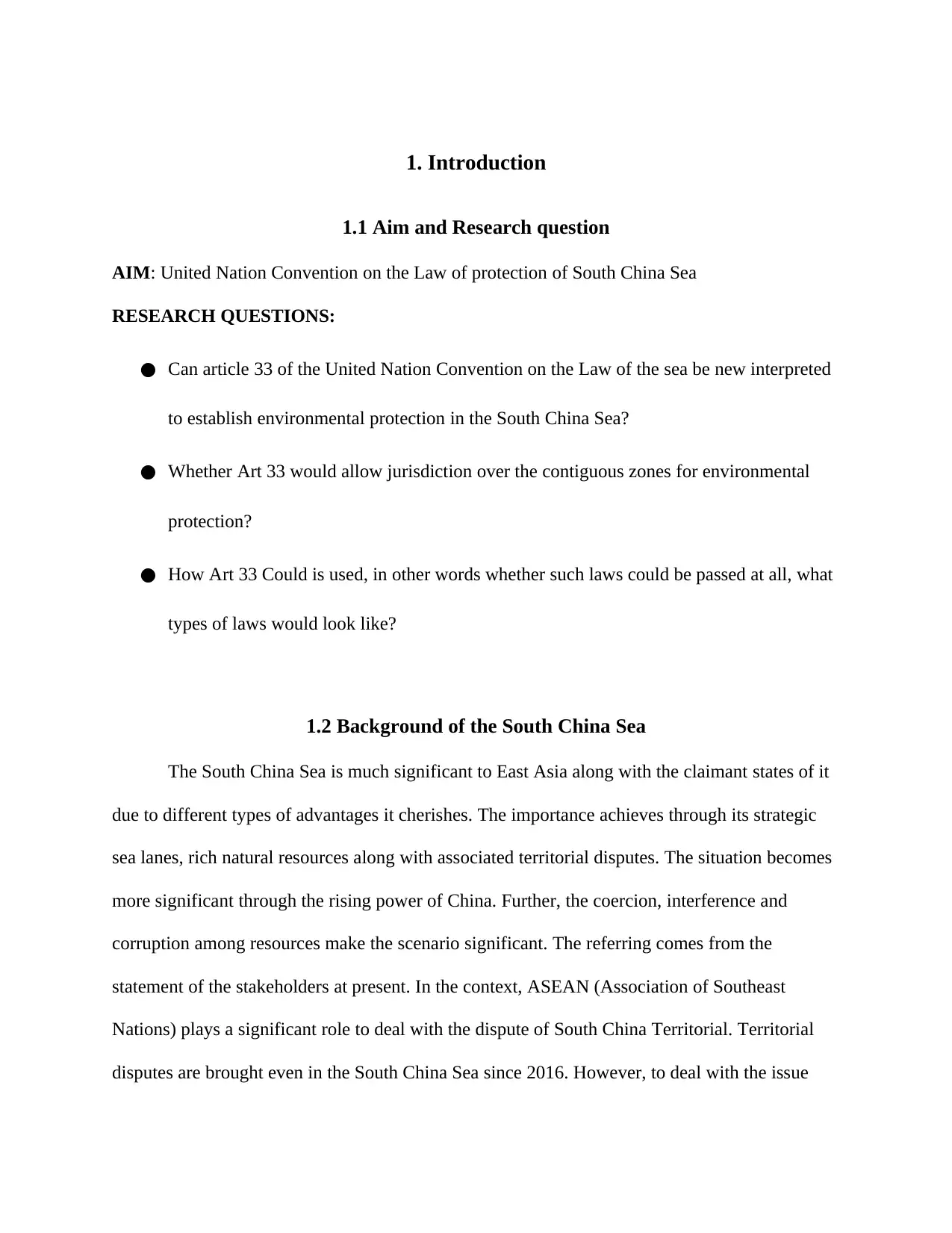
1. Introduction
1.1 Aim and Research question
AIM: United Nation Convention on the Law of protection of South China Sea
RESEARCH QUESTIONS:
● Can article 33 of the United Nation Convention on the Law of the sea be new interpreted
to establish environmental protection in the South China Sea?
● Whether Art 33 would allow jurisdiction over the contiguous zones for environmental
protection?
● How Art 33 Could is used, in other words whether such laws could be passed at all, what
types of laws would look like?
1.2 Background of the South China Sea
The South China Sea is much significant to East Asia along with the claimant states of it
due to different types of advantages it cherishes. The importance achieves through its strategic
sea lanes, rich natural resources along with associated territorial disputes. The situation becomes
more significant through the rising power of China. Further, the coercion, interference and
corruption among resources make the scenario significant. The referring comes from the
statement of the stakeholders at present. In the context, ASEAN (Association of Southeast
Nations) plays a significant role to deal with the dispute of South China Territorial. Territorial
disputes are brought even in the South China Sea since 2016. However, to deal with the issue
1.1 Aim and Research question
AIM: United Nation Convention on the Law of protection of South China Sea
RESEARCH QUESTIONS:
● Can article 33 of the United Nation Convention on the Law of the sea be new interpreted
to establish environmental protection in the South China Sea?
● Whether Art 33 would allow jurisdiction over the contiguous zones for environmental
protection?
● How Art 33 Could is used, in other words whether such laws could be passed at all, what
types of laws would look like?
1.2 Background of the South China Sea
The South China Sea is much significant to East Asia along with the claimant states of it
due to different types of advantages it cherishes. The importance achieves through its strategic
sea lanes, rich natural resources along with associated territorial disputes. The situation becomes
more significant through the rising power of China. Further, the coercion, interference and
corruption among resources make the scenario significant. The referring comes from the
statement of the stakeholders at present. In the context, ASEAN (Association of Southeast
Nations) plays a significant role to deal with the dispute of South China Territorial. Territorial
disputes are brought even in the South China Sea since 2016. However, to deal with the issue
⊘ This is a preview!⊘
Do you want full access?
Subscribe today to unlock all pages.

Trusted by 1+ million students worldwide
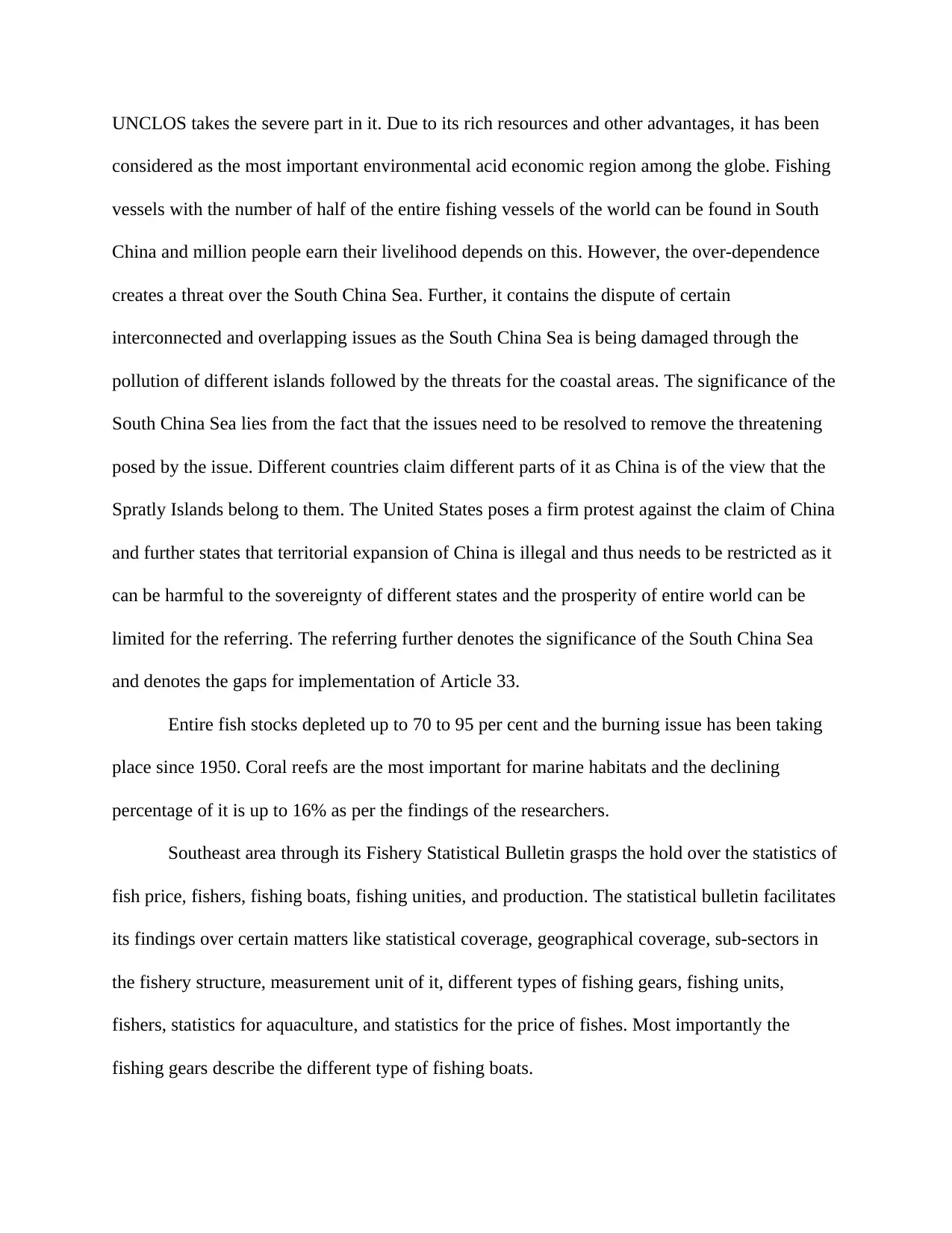
UNCLOS takes the severe part in it. Due to its rich resources and other advantages, it has been
considered as the most important environmental acid economic region among the globe. Fishing
vessels with the number of half of the entire fishing vessels of the world can be found in South
China and million people earn their livelihood depends on this. However, the over-dependence
creates a threat over the South China Sea. Further, it contains the dispute of certain
interconnected and overlapping issues as the South China Sea is being damaged through the
pollution of different islands followed by the threats for the coastal areas. The significance of the
South China Sea lies from the fact that the issues need to be resolved to remove the threatening
posed by the issue. Different countries claim different parts of it as China is of the view that the
Spratly Islands belong to them. The United States poses a firm protest against the claim of China
and further states that territorial expansion of China is illegal and thus needs to be restricted as it
can be harmful to the sovereignty of different states and the prosperity of entire world can be
limited for the referring. The referring further denotes the significance of the South China Sea
and denotes the gaps for implementation of Article 33.
Entire fish stocks depleted up to 70 to 95 per cent and the burning issue has been taking
place since 1950. Coral reefs are the most important for marine habitats and the declining
percentage of it is up to 16% as per the findings of the researchers.
Southeast area through its Fishery Statistical Bulletin grasps the hold over the statistics of
fish price, fishers, fishing boats, fishing unities, and production. The statistical bulletin facilitates
its findings over certain matters like statistical coverage, geographical coverage, sub-sectors in
the fishery structure, measurement unit of it, different types of fishing gears, fishing units,
fishers, statistics for aquaculture, and statistics for the price of fishes. Most importantly the
fishing gears describe the different type of fishing boats.
considered as the most important environmental acid economic region among the globe. Fishing
vessels with the number of half of the entire fishing vessels of the world can be found in South
China and million people earn their livelihood depends on this. However, the over-dependence
creates a threat over the South China Sea. Further, it contains the dispute of certain
interconnected and overlapping issues as the South China Sea is being damaged through the
pollution of different islands followed by the threats for the coastal areas. The significance of the
South China Sea lies from the fact that the issues need to be resolved to remove the threatening
posed by the issue. Different countries claim different parts of it as China is of the view that the
Spratly Islands belong to them. The United States poses a firm protest against the claim of China
and further states that territorial expansion of China is illegal and thus needs to be restricted as it
can be harmful to the sovereignty of different states and the prosperity of entire world can be
limited for the referring. The referring further denotes the significance of the South China Sea
and denotes the gaps for implementation of Article 33.
Entire fish stocks depleted up to 70 to 95 per cent and the burning issue has been taking
place since 1950. Coral reefs are the most important for marine habitats and the declining
percentage of it is up to 16% as per the findings of the researchers.
Southeast area through its Fishery Statistical Bulletin grasps the hold over the statistics of
fish price, fishers, fishing boats, fishing unities, and production. The statistical bulletin facilitates
its findings over certain matters like statistical coverage, geographical coverage, sub-sectors in
the fishery structure, measurement unit of it, different types of fishing gears, fishing units,
fishers, statistics for aquaculture, and statistics for the price of fishes. Most importantly the
fishing gears describe the different type of fishing boats.
Paraphrase This Document
Need a fresh take? Get an instant paraphrase of this document with our AI Paraphraser
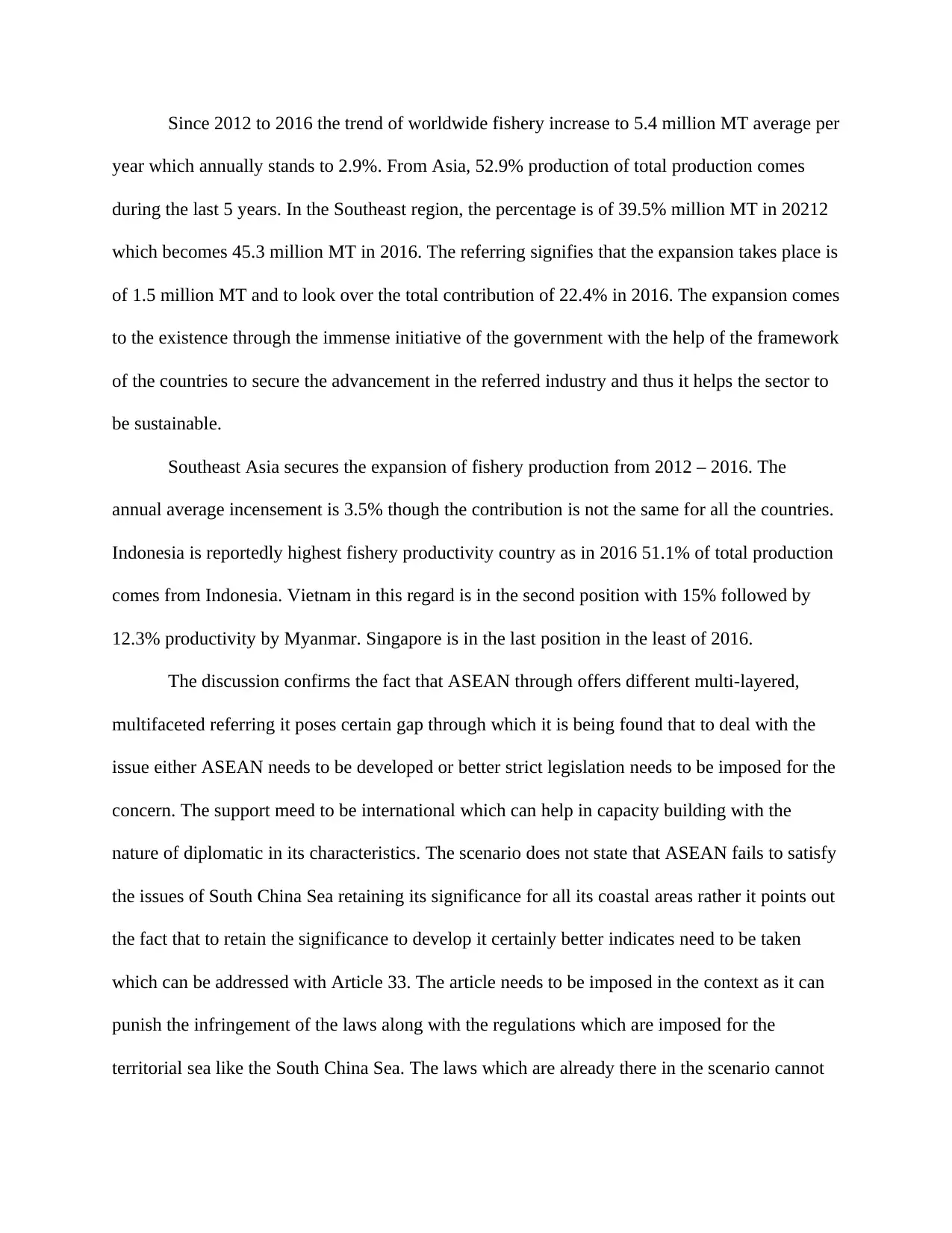
Since 2012 to 2016 the trend of worldwide fishery increase to 5.4 million MT average per
year which annually stands to 2.9%. From Asia, 52.9% production of total production comes
during the last 5 years. In the Southeast region, the percentage is of 39.5% million MT in 20212
which becomes 45.3 million MT in 2016. The referring signifies that the expansion takes place is
of 1.5 million MT and to look over the total contribution of 22.4% in 2016. The expansion comes
to the existence through the immense initiative of the government with the help of the framework
of the countries to secure the advancement in the referred industry and thus it helps the sector to
be sustainable.
Southeast Asia secures the expansion of fishery production from 2012 – 2016. The
annual average incensement is 3.5% though the contribution is not the same for all the countries.
Indonesia is reportedly highest fishery productivity country as in 2016 51.1% of total production
comes from Indonesia. Vietnam in this regard is in the second position with 15% followed by
12.3% productivity by Myanmar. Singapore is in the last position in the least of 2016.
The discussion confirms the fact that ASEAN through offers different multi-layered,
multifaceted referring it poses certain gap through which it is being found that to deal with the
issue either ASEAN needs to be developed or better strict legislation needs to be imposed for the
concern. The support meed to be international which can help in capacity building with the
nature of diplomatic in its characteristics. The scenario does not state that ASEAN fails to satisfy
the issues of South China Sea retaining its significance for all its coastal areas rather it points out
the fact that to retain the significance to develop it certainly better indicates need to be taken
which can be addressed with Article 33. The article needs to be imposed in the context as it can
punish the infringement of the laws along with the regulations which are imposed for the
territorial sea like the South China Sea. The laws which are already there in the scenario cannot
year which annually stands to 2.9%. From Asia, 52.9% production of total production comes
during the last 5 years. In the Southeast region, the percentage is of 39.5% million MT in 20212
which becomes 45.3 million MT in 2016. The referring signifies that the expansion takes place is
of 1.5 million MT and to look over the total contribution of 22.4% in 2016. The expansion comes
to the existence through the immense initiative of the government with the help of the framework
of the countries to secure the advancement in the referred industry and thus it helps the sector to
be sustainable.
Southeast Asia secures the expansion of fishery production from 2012 – 2016. The
annual average incensement is 3.5% though the contribution is not the same for all the countries.
Indonesia is reportedly highest fishery productivity country as in 2016 51.1% of total production
comes from Indonesia. Vietnam in this regard is in the second position with 15% followed by
12.3% productivity by Myanmar. Singapore is in the last position in the least of 2016.
The discussion confirms the fact that ASEAN through offers different multi-layered,
multifaceted referring it poses certain gap through which it is being found that to deal with the
issue either ASEAN needs to be developed or better strict legislation needs to be imposed for the
concern. The support meed to be international which can help in capacity building with the
nature of diplomatic in its characteristics. The scenario does not state that ASEAN fails to satisfy
the issues of South China Sea retaining its significance for all its coastal areas rather it points out
the fact that to retain the significance to develop it certainly better indicates need to be taken
which can be addressed with Article 33. The article needs to be imposed in the context as it can
punish the infringement of the laws along with the regulations which are imposed for the
territorial sea like the South China Sea. The laws which are already there in the scenario cannot
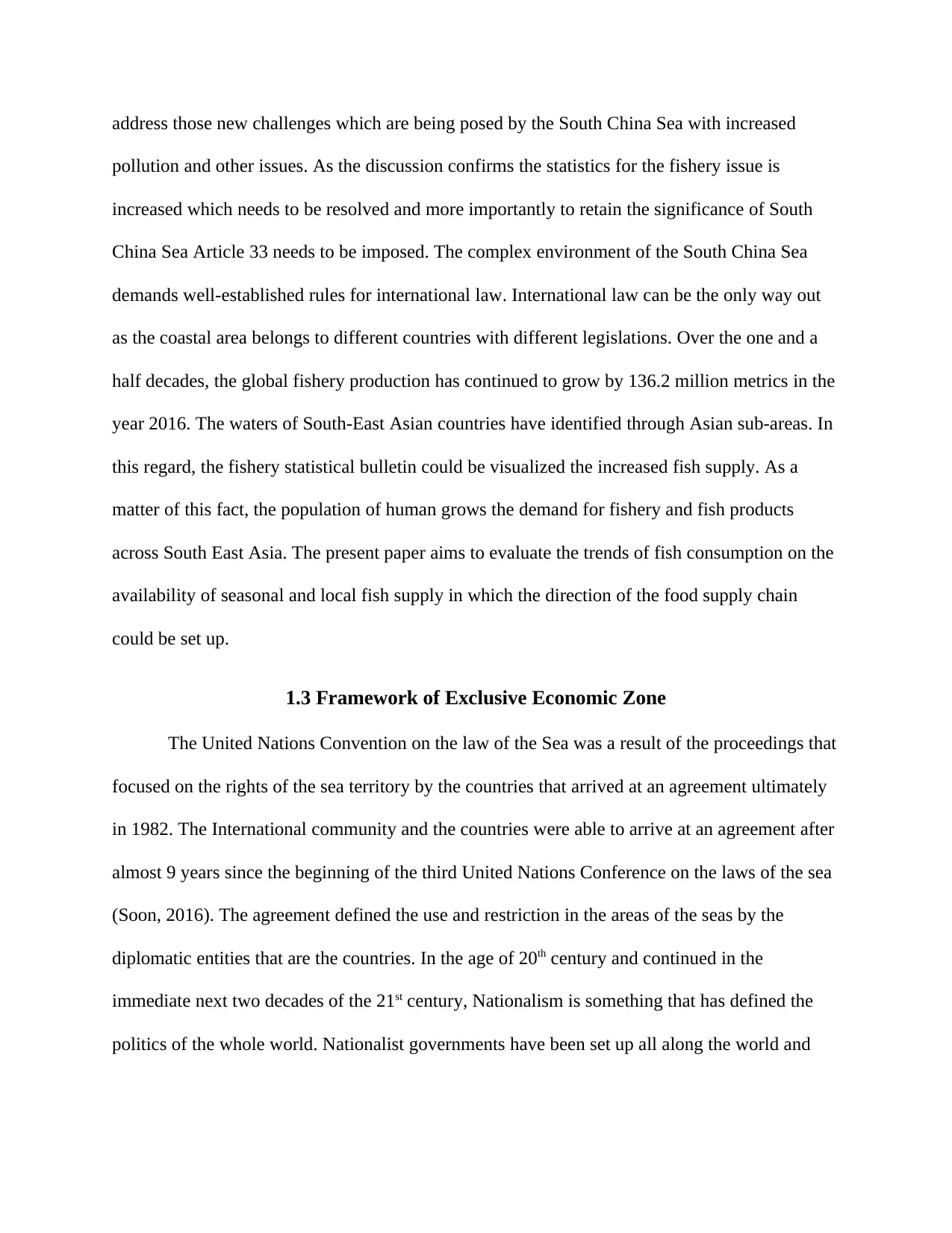
address those new challenges which are being posed by the South China Sea with increased
pollution and other issues. As the discussion confirms the statistics for the fishery issue is
increased which needs to be resolved and more importantly to retain the significance of South
China Sea Article 33 needs to be imposed. The complex environment of the South China Sea
demands well-established rules for international law. International law can be the only way out
as the coastal area belongs to different countries with different legislations. Over the one and a
half decades, the global fishery production has continued to grow by 136.2 million metrics in the
year 2016. The waters of South-East Asian countries have identified through Asian sub-areas. In
this regard, the fishery statistical bulletin could be visualized the increased fish supply. As a
matter of this fact, the population of human grows the demand for fishery and fish products
across South East Asia. The present paper aims to evaluate the trends of fish consumption on the
availability of seasonal and local fish supply in which the direction of the food supply chain
could be set up.
1.3 Framework of Exclusive Economic Zone
The United Nations Convention on the law of the Sea was a result of the proceedings that
focused on the rights of the sea territory by the countries that arrived at an agreement ultimately
in 1982. The International community and the countries were able to arrive at an agreement after
almost 9 years since the beginning of the third United Nations Conference on the laws of the sea
(Soon, 2016). The agreement defined the use and restriction in the areas of the seas by the
diplomatic entities that are the countries. In the age of 20th century and continued in the
immediate next two decades of the 21st century, Nationalism is something that has defined the
politics of the whole world. Nationalist governments have been set up all along the world and
pollution and other issues. As the discussion confirms the statistics for the fishery issue is
increased which needs to be resolved and more importantly to retain the significance of South
China Sea Article 33 needs to be imposed. The complex environment of the South China Sea
demands well-established rules for international law. International law can be the only way out
as the coastal area belongs to different countries with different legislations. Over the one and a
half decades, the global fishery production has continued to grow by 136.2 million metrics in the
year 2016. The waters of South-East Asian countries have identified through Asian sub-areas. In
this regard, the fishery statistical bulletin could be visualized the increased fish supply. As a
matter of this fact, the population of human grows the demand for fishery and fish products
across South East Asia. The present paper aims to evaluate the trends of fish consumption on the
availability of seasonal and local fish supply in which the direction of the food supply chain
could be set up.
1.3 Framework of Exclusive Economic Zone
The United Nations Convention on the law of the Sea was a result of the proceedings that
focused on the rights of the sea territory by the countries that arrived at an agreement ultimately
in 1982. The International community and the countries were able to arrive at an agreement after
almost 9 years since the beginning of the third United Nations Conference on the laws of the sea
(Soon, 2016). The agreement defined the use and restriction in the areas of the seas by the
diplomatic entities that are the countries. In the age of 20th century and continued in the
immediate next two decades of the 21st century, Nationalism is something that has defined the
politics of the whole world. Nationalist governments have been set up all along the world and
⊘ This is a preview!⊘
Do you want full access?
Subscribe today to unlock all pages.

Trusted by 1+ million students worldwide
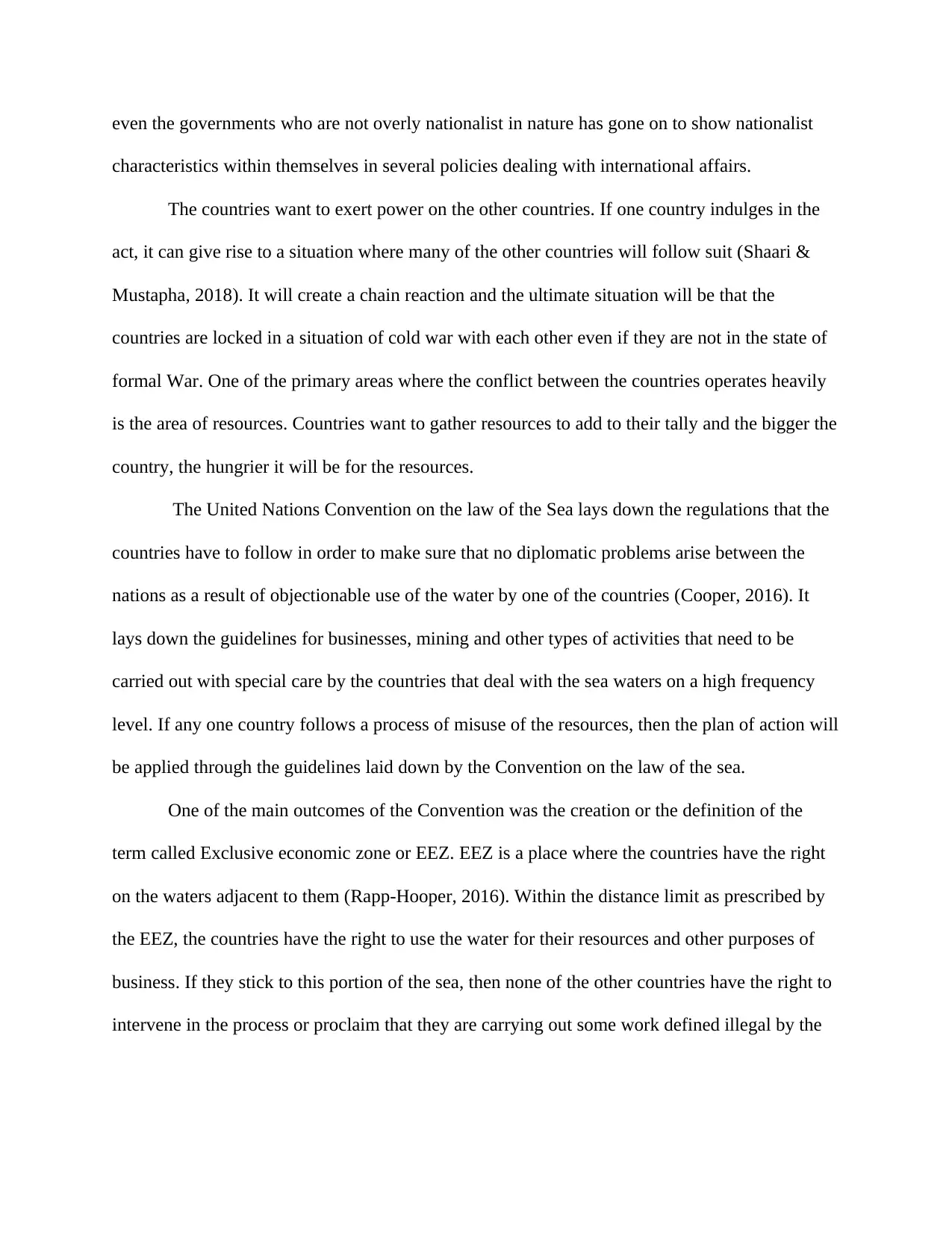
even the governments who are not overly nationalist in nature has gone on to show nationalist
characteristics within themselves in several policies dealing with international affairs.
The countries want to exert power on the other countries. If one country indulges in the
act, it can give rise to a situation where many of the other countries will follow suit (Shaari &
Mustapha, 2018). It will create a chain reaction and the ultimate situation will be that the
countries are locked in a situation of cold war with each other even if they are not in the state of
formal War. One of the primary areas where the conflict between the countries operates heavily
is the area of resources. Countries want to gather resources to add to their tally and the bigger the
country, the hungrier it will be for the resources.
The United Nations Convention on the law of the Sea lays down the regulations that the
countries have to follow in order to make sure that no diplomatic problems arise between the
nations as a result of objectionable use of the water by one of the countries (Cooper, 2016). It
lays down the guidelines for businesses, mining and other types of activities that need to be
carried out with special care by the countries that deal with the sea waters on a high frequency
level. If any one country follows a process of misuse of the resources, then the plan of action will
be applied through the guidelines laid down by the Convention on the law of the sea.
One of the main outcomes of the Convention was the creation or the definition of the
term called Exclusive economic zone or EEZ. EEZ is a place where the countries have the right
on the waters adjacent to them (Rapp-Hooper, 2016). Within the distance limit as prescribed by
the EEZ, the countries have the right to use the water for their resources and other purposes of
business. If they stick to this portion of the sea, then none of the other countries have the right to
intervene in the process or proclaim that they are carrying out some work defined illegal by the
characteristics within themselves in several policies dealing with international affairs.
The countries want to exert power on the other countries. If one country indulges in the
act, it can give rise to a situation where many of the other countries will follow suit (Shaari &
Mustapha, 2018). It will create a chain reaction and the ultimate situation will be that the
countries are locked in a situation of cold war with each other even if they are not in the state of
formal War. One of the primary areas where the conflict between the countries operates heavily
is the area of resources. Countries want to gather resources to add to their tally and the bigger the
country, the hungrier it will be for the resources.
The United Nations Convention on the law of the Sea lays down the regulations that the
countries have to follow in order to make sure that no diplomatic problems arise between the
nations as a result of objectionable use of the water by one of the countries (Cooper, 2016). It
lays down the guidelines for businesses, mining and other types of activities that need to be
carried out with special care by the countries that deal with the sea waters on a high frequency
level. If any one country follows a process of misuse of the resources, then the plan of action will
be applied through the guidelines laid down by the Convention on the law of the sea.
One of the main outcomes of the Convention was the creation or the definition of the
term called Exclusive economic zone or EEZ. EEZ is a place where the countries have the right
on the waters adjacent to them (Rapp-Hooper, 2016). Within the distance limit as prescribed by
the EEZ, the countries have the right to use the water for their resources and other purposes of
business. If they stick to this portion of the sea, then none of the other countries have the right to
intervene in the process or proclaim that they are carrying out some work defined illegal by the
Paraphrase This Document
Need a fresh take? Get an instant paraphrase of this document with our AI Paraphraser
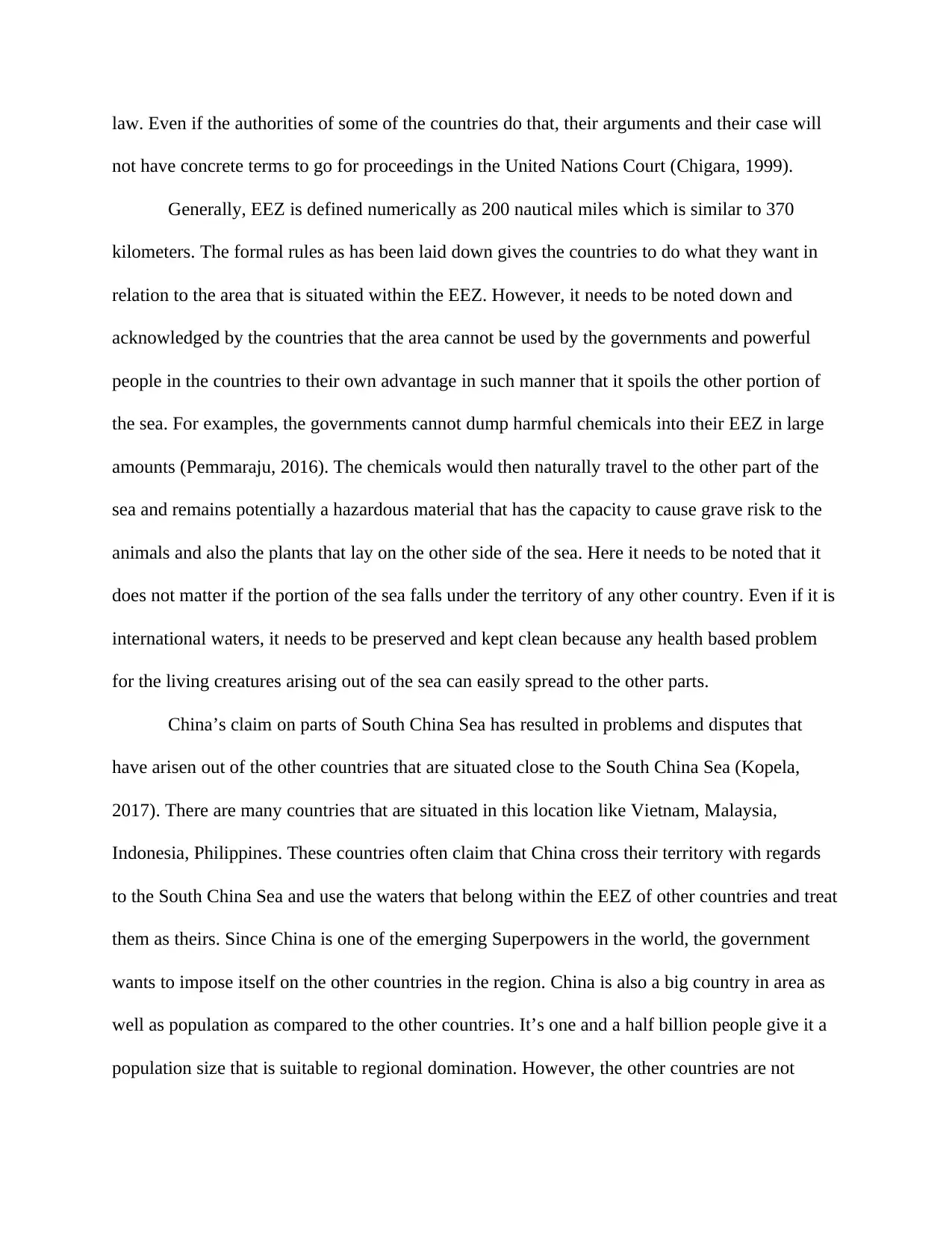
law. Even if the authorities of some of the countries do that, their arguments and their case will
not have concrete terms to go for proceedings in the United Nations Court (Chigara, 1999).
Generally, EEZ is defined numerically as 200 nautical miles which is similar to 370
kilometers. The formal rules as has been laid down gives the countries to do what they want in
relation to the area that is situated within the EEZ. However, it needs to be noted down and
acknowledged by the countries that the area cannot be used by the governments and powerful
people in the countries to their own advantage in such manner that it spoils the other portion of
the sea. For examples, the governments cannot dump harmful chemicals into their EEZ in large
amounts (Pemmaraju, 2016). The chemicals would then naturally travel to the other part of the
sea and remains potentially a hazardous material that has the capacity to cause grave risk to the
animals and also the plants that lay on the other side of the sea. Here it needs to be noted that it
does not matter if the portion of the sea falls under the territory of any other country. Even if it is
international waters, it needs to be preserved and kept clean because any health based problem
for the living creatures arising out of the sea can easily spread to the other parts.
China’s claim on parts of South China Sea has resulted in problems and disputes that
have arisen out of the other countries that are situated close to the South China Sea (Kopela,
2017). There are many countries that are situated in this location like Vietnam, Malaysia,
Indonesia, Philippines. These countries often claim that China cross their territory with regards
to the South China Sea and use the waters that belong within the EEZ of other countries and treat
them as theirs. Since China is one of the emerging Superpowers in the world, the government
wants to impose itself on the other countries in the region. China is also a big country in area as
well as population as compared to the other countries. It’s one and a half billion people give it a
population size that is suitable to regional domination. However, the other countries are not
not have concrete terms to go for proceedings in the United Nations Court (Chigara, 1999).
Generally, EEZ is defined numerically as 200 nautical miles which is similar to 370
kilometers. The formal rules as has been laid down gives the countries to do what they want in
relation to the area that is situated within the EEZ. However, it needs to be noted down and
acknowledged by the countries that the area cannot be used by the governments and powerful
people in the countries to their own advantage in such manner that it spoils the other portion of
the sea. For examples, the governments cannot dump harmful chemicals into their EEZ in large
amounts (Pemmaraju, 2016). The chemicals would then naturally travel to the other part of the
sea and remains potentially a hazardous material that has the capacity to cause grave risk to the
animals and also the plants that lay on the other side of the sea. Here it needs to be noted that it
does not matter if the portion of the sea falls under the territory of any other country. Even if it is
international waters, it needs to be preserved and kept clean because any health based problem
for the living creatures arising out of the sea can easily spread to the other parts.
China’s claim on parts of South China Sea has resulted in problems and disputes that
have arisen out of the other countries that are situated close to the South China Sea (Kopela,
2017). There are many countries that are situated in this location like Vietnam, Malaysia,
Indonesia, Philippines. These countries often claim that China cross their territory with regards
to the South China Sea and use the waters that belong within the EEZ of other countries and treat
them as theirs. Since China is one of the emerging Superpowers in the world, the government
wants to impose itself on the other countries in the region. China is also a big country in area as
well as population as compared to the other countries. It’s one and a half billion people give it a
population size that is suitable to regional domination. However, the other countries are not
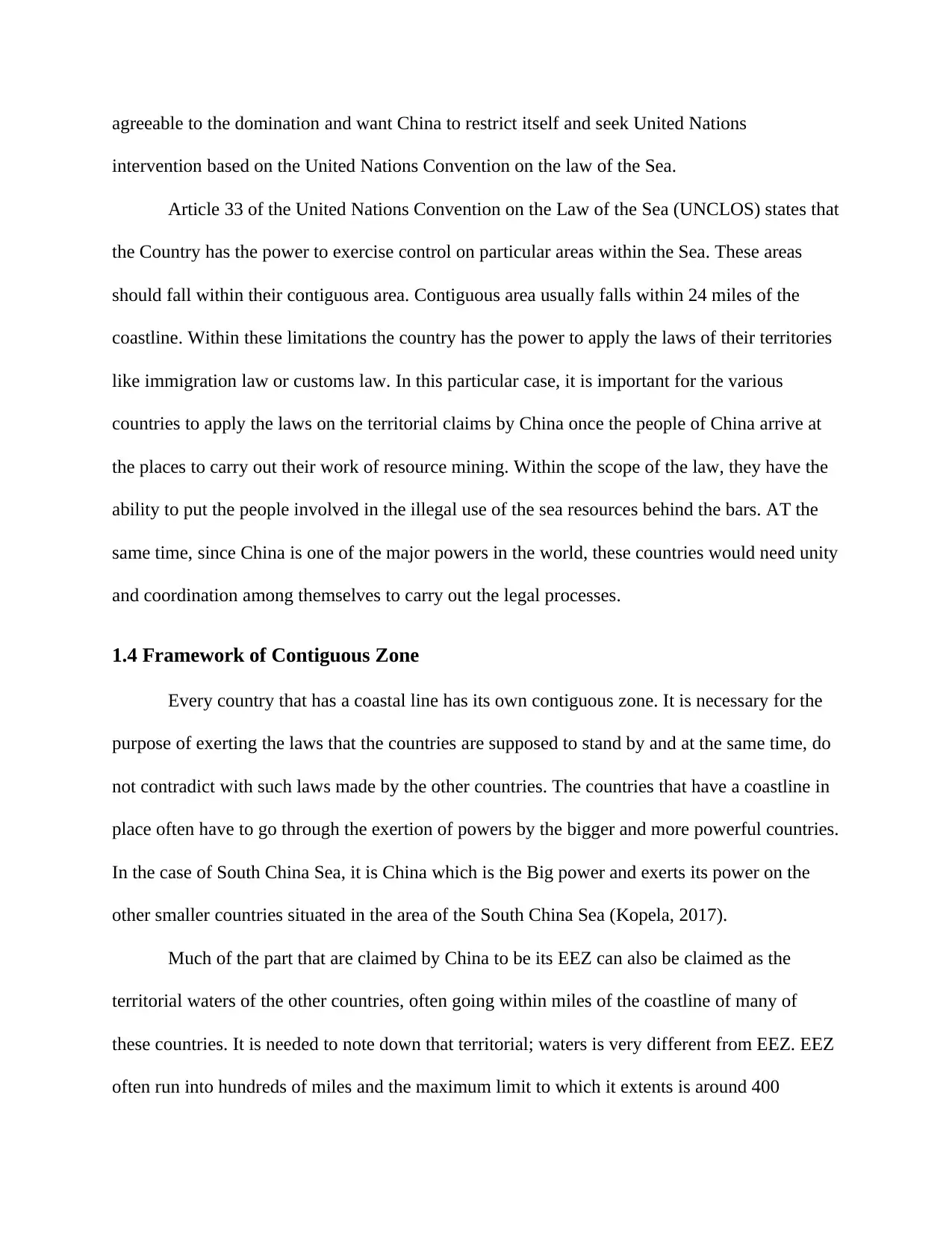
agreeable to the domination and want China to restrict itself and seek United Nations
intervention based on the United Nations Convention on the law of the Sea.
Article 33 of the United Nations Convention on the Law of the Sea (UNCLOS) states that
the Country has the power to exercise control on particular areas within the Sea. These areas
should fall within their contiguous area. Contiguous area usually falls within 24 miles of the
coastline. Within these limitations the country has the power to apply the laws of their territories
like immigration law or customs law. In this particular case, it is important for the various
countries to apply the laws on the territorial claims by China once the people of China arrive at
the places to carry out their work of resource mining. Within the scope of the law, they have the
ability to put the people involved in the illegal use of the sea resources behind the bars. AT the
same time, since China is one of the major powers in the world, these countries would need unity
and coordination among themselves to carry out the legal processes.
1.4 Framework of Contiguous Zone
Every country that has a coastal line has its own contiguous zone. It is necessary for the
purpose of exerting the laws that the countries are supposed to stand by and at the same time, do
not contradict with such laws made by the other countries. The countries that have a coastline in
place often have to go through the exertion of powers by the bigger and more powerful countries.
In the case of South China Sea, it is China which is the Big power and exerts its power on the
other smaller countries situated in the area of the South China Sea (Kopela, 2017).
Much of the part that are claimed by China to be its EEZ can also be claimed as the
territorial waters of the other countries, often going within miles of the coastline of many of
these countries. It is needed to note down that territorial; waters is very different from EEZ. EEZ
often run into hundreds of miles and the maximum limit to which it extents is around 400
intervention based on the United Nations Convention on the law of the Sea.
Article 33 of the United Nations Convention on the Law of the Sea (UNCLOS) states that
the Country has the power to exercise control on particular areas within the Sea. These areas
should fall within their contiguous area. Contiguous area usually falls within 24 miles of the
coastline. Within these limitations the country has the power to apply the laws of their territories
like immigration law or customs law. In this particular case, it is important for the various
countries to apply the laws on the territorial claims by China once the people of China arrive at
the places to carry out their work of resource mining. Within the scope of the law, they have the
ability to put the people involved in the illegal use of the sea resources behind the bars. AT the
same time, since China is one of the major powers in the world, these countries would need unity
and coordination among themselves to carry out the legal processes.
1.4 Framework of Contiguous Zone
Every country that has a coastal line has its own contiguous zone. It is necessary for the
purpose of exerting the laws that the countries are supposed to stand by and at the same time, do
not contradict with such laws made by the other countries. The countries that have a coastline in
place often have to go through the exertion of powers by the bigger and more powerful countries.
In the case of South China Sea, it is China which is the Big power and exerts its power on the
other smaller countries situated in the area of the South China Sea (Kopela, 2017).
Much of the part that are claimed by China to be its EEZ can also be claimed as the
territorial waters of the other countries, often going within miles of the coastline of many of
these countries. It is needed to note down that territorial; waters is very different from EEZ. EEZ
often run into hundreds of miles and the maximum limit to which it extents is around 400
⊘ This is a preview!⊘
Do you want full access?
Subscribe today to unlock all pages.

Trusted by 1+ million students worldwide
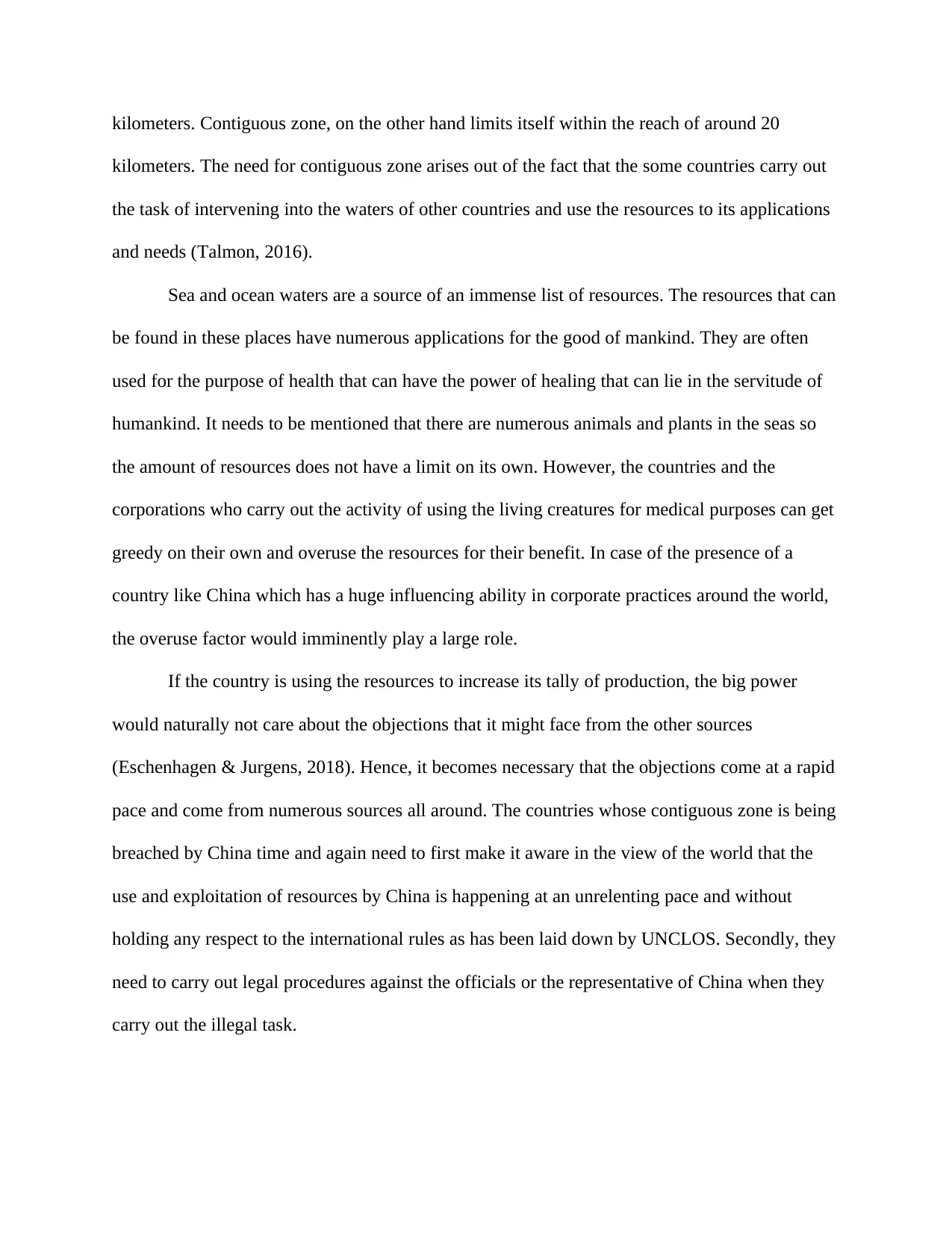
kilometers. Contiguous zone, on the other hand limits itself within the reach of around 20
kilometers. The need for contiguous zone arises out of the fact that the some countries carry out
the task of intervening into the waters of other countries and use the resources to its applications
and needs (Talmon, 2016).
Sea and ocean waters are a source of an immense list of resources. The resources that can
be found in these places have numerous applications for the good of mankind. They are often
used for the purpose of health that can have the power of healing that can lie in the servitude of
humankind. It needs to be mentioned that there are numerous animals and plants in the seas so
the amount of resources does not have a limit on its own. However, the countries and the
corporations who carry out the activity of using the living creatures for medical purposes can get
greedy on their own and overuse the resources for their benefit. In case of the presence of a
country like China which has a huge influencing ability in corporate practices around the world,
the overuse factor would imminently play a large role.
If the country is using the resources to increase its tally of production, the big power
would naturally not care about the objections that it might face from the other sources
(Eschenhagen & Jurgens, 2018). Hence, it becomes necessary that the objections come at a rapid
pace and come from numerous sources all around. The countries whose contiguous zone is being
breached by China time and again need to first make it aware in the view of the world that the
use and exploitation of resources by China is happening at an unrelenting pace and without
holding any respect to the international rules as has been laid down by UNCLOS. Secondly, they
need to carry out legal procedures against the officials or the representative of China when they
carry out the illegal task.
kilometers. The need for contiguous zone arises out of the fact that the some countries carry out
the task of intervening into the waters of other countries and use the resources to its applications
and needs (Talmon, 2016).
Sea and ocean waters are a source of an immense list of resources. The resources that can
be found in these places have numerous applications for the good of mankind. They are often
used for the purpose of health that can have the power of healing that can lie in the servitude of
humankind. It needs to be mentioned that there are numerous animals and plants in the seas so
the amount of resources does not have a limit on its own. However, the countries and the
corporations who carry out the activity of using the living creatures for medical purposes can get
greedy on their own and overuse the resources for their benefit. In case of the presence of a
country like China which has a huge influencing ability in corporate practices around the world,
the overuse factor would imminently play a large role.
If the country is using the resources to increase its tally of production, the big power
would naturally not care about the objections that it might face from the other sources
(Eschenhagen & Jurgens, 2018). Hence, it becomes necessary that the objections come at a rapid
pace and come from numerous sources all around. The countries whose contiguous zone is being
breached by China time and again need to first make it aware in the view of the world that the
use and exploitation of resources by China is happening at an unrelenting pace and without
holding any respect to the international rules as has been laid down by UNCLOS. Secondly, they
need to carry out legal procedures against the officials or the representative of China when they
carry out the illegal task.
Paraphrase This Document
Need a fresh take? Get an instant paraphrase of this document with our AI Paraphraser
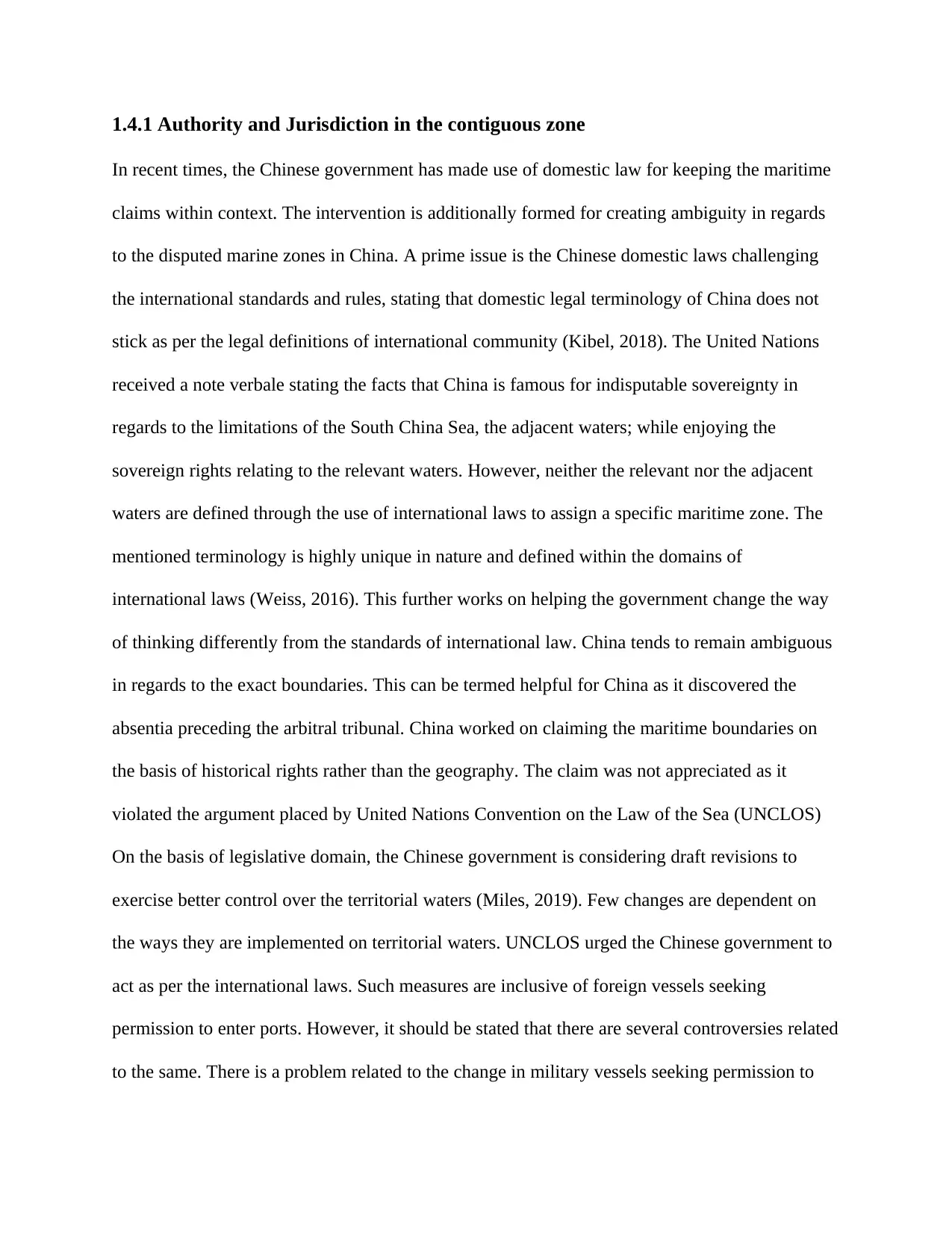
1.4.1 Authority and Jurisdiction in the contiguous zone
In recent times, the Chinese government has made use of domestic law for keeping the maritime
claims within context. The intervention is additionally formed for creating ambiguity in regards
to the disputed marine zones in China. A prime issue is the Chinese domestic laws challenging
the international standards and rules, stating that domestic legal terminology of China does not
stick as per the legal definitions of international community (Kibel, 2018). The United Nations
received a note verbale stating the facts that China is famous for indisputable sovereignty in
regards to the limitations of the South China Sea, the adjacent waters; while enjoying the
sovereign rights relating to the relevant waters. However, neither the relevant nor the adjacent
waters are defined through the use of international laws to assign a specific maritime zone. The
mentioned terminology is highly unique in nature and defined within the domains of
international laws (Weiss, 2016). This further works on helping the government change the way
of thinking differently from the standards of international law. China tends to remain ambiguous
in regards to the exact boundaries. This can be termed helpful for China as it discovered the
absentia preceding the arbitral tribunal. China worked on claiming the maritime boundaries on
the basis of historical rights rather than the geography. The claim was not appreciated as it
violated the argument placed by United Nations Convention on the Law of the Sea (UNCLOS)
On the basis of legislative domain, the Chinese government is considering draft revisions to
exercise better control over the territorial waters (Miles, 2019). Few changes are dependent on
the ways they are implemented on territorial waters. UNCLOS urged the Chinese government to
act as per the international laws. Such measures are inclusive of foreign vessels seeking
permission to enter ports. However, it should be stated that there are several controversies related
to the same. There is a problem related to the change in military vessels seeking permission to
In recent times, the Chinese government has made use of domestic law for keeping the maritime
claims within context. The intervention is additionally formed for creating ambiguity in regards
to the disputed marine zones in China. A prime issue is the Chinese domestic laws challenging
the international standards and rules, stating that domestic legal terminology of China does not
stick as per the legal definitions of international community (Kibel, 2018). The United Nations
received a note verbale stating the facts that China is famous for indisputable sovereignty in
regards to the limitations of the South China Sea, the adjacent waters; while enjoying the
sovereign rights relating to the relevant waters. However, neither the relevant nor the adjacent
waters are defined through the use of international laws to assign a specific maritime zone. The
mentioned terminology is highly unique in nature and defined within the domains of
international laws (Weiss, 2016). This further works on helping the government change the way
of thinking differently from the standards of international law. China tends to remain ambiguous
in regards to the exact boundaries. This can be termed helpful for China as it discovered the
absentia preceding the arbitral tribunal. China worked on claiming the maritime boundaries on
the basis of historical rights rather than the geography. The claim was not appreciated as it
violated the argument placed by United Nations Convention on the Law of the Sea (UNCLOS)
On the basis of legislative domain, the Chinese government is considering draft revisions to
exercise better control over the territorial waters (Miles, 2019). Few changes are dependent on
the ways they are implemented on territorial waters. UNCLOS urged the Chinese government to
act as per the international laws. Such measures are inclusive of foreign vessels seeking
permission to enter ports. However, it should be stated that there are several controversies related
to the same. There is a problem related to the change in military vessels seeking permission to
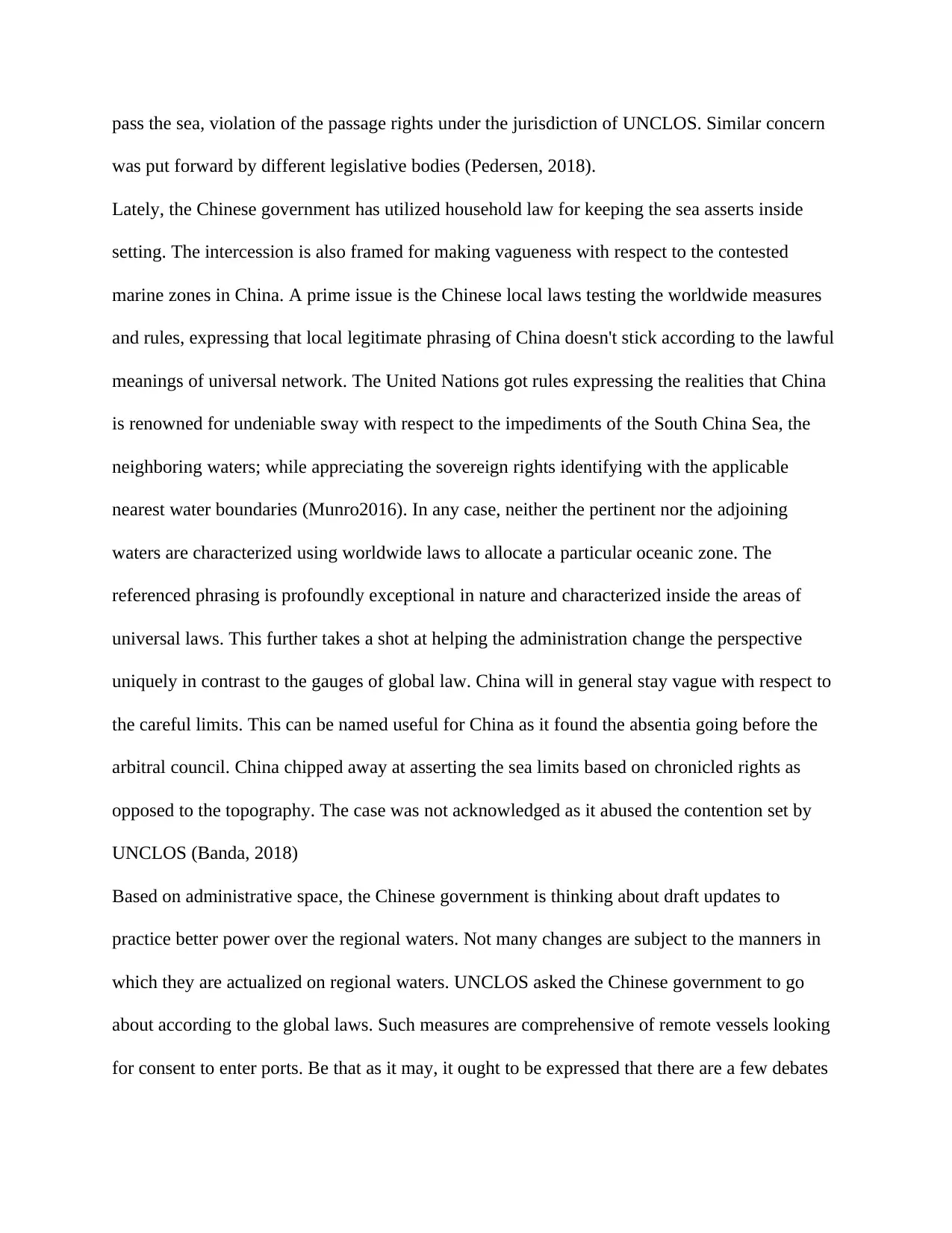
pass the sea, violation of the passage rights under the jurisdiction of UNCLOS. Similar concern
was put forward by different legislative bodies (Pedersen, 2018).
Lately, the Chinese government has utilized household law for keeping the sea asserts inside
setting. The intercession is also framed for making vagueness with respect to the contested
marine zones in China. A prime issue is the Chinese local laws testing the worldwide measures
and rules, expressing that local legitimate phrasing of China doesn't stick according to the lawful
meanings of universal network. The United Nations got rules expressing the realities that China
is renowned for undeniable sway with respect to the impediments of the South China Sea, the
neighboring waters; while appreciating the sovereign rights identifying with the applicable
nearest water boundaries (Munro2016). In any case, neither the pertinent nor the adjoining
waters are characterized using worldwide laws to allocate a particular oceanic zone. The
referenced phrasing is profoundly exceptional in nature and characterized inside the areas of
universal laws. This further takes a shot at helping the administration change the perspective
uniquely in contrast to the gauges of global law. China will in general stay vague with respect to
the careful limits. This can be named useful for China as it found the absentia going before the
arbitral council. China chipped away at asserting the sea limits based on chronicled rights as
opposed to the topography. The case was not acknowledged as it abused the contention set by
UNCLOS (Banda, 2018)
Based on administrative space, the Chinese government is thinking about draft updates to
practice better power over the regional waters. Not many changes are subject to the manners in
which they are actualized on regional waters. UNCLOS asked the Chinese government to go
about according to the global laws. Such measures are comprehensive of remote vessels looking
for consent to enter ports. Be that as it may, it ought to be expressed that there are a few debates
was put forward by different legislative bodies (Pedersen, 2018).
Lately, the Chinese government has utilized household law for keeping the sea asserts inside
setting. The intercession is also framed for making vagueness with respect to the contested
marine zones in China. A prime issue is the Chinese local laws testing the worldwide measures
and rules, expressing that local legitimate phrasing of China doesn't stick according to the lawful
meanings of universal network. The United Nations got rules expressing the realities that China
is renowned for undeniable sway with respect to the impediments of the South China Sea, the
neighboring waters; while appreciating the sovereign rights identifying with the applicable
nearest water boundaries (Munro2016). In any case, neither the pertinent nor the adjoining
waters are characterized using worldwide laws to allocate a particular oceanic zone. The
referenced phrasing is profoundly exceptional in nature and characterized inside the areas of
universal laws. This further takes a shot at helping the administration change the perspective
uniquely in contrast to the gauges of global law. China will in general stay vague with respect to
the careful limits. This can be named useful for China as it found the absentia going before the
arbitral council. China chipped away at asserting the sea limits based on chronicled rights as
opposed to the topography. The case was not acknowledged as it abused the contention set by
UNCLOS (Banda, 2018)
Based on administrative space, the Chinese government is thinking about draft updates to
practice better power over the regional waters. Not many changes are subject to the manners in
which they are actualized on regional waters. UNCLOS asked the Chinese government to go
about according to the global laws. Such measures are comprehensive of remote vessels looking
for consent to enter ports. Be that as it may, it ought to be expressed that there are a few debates
⊘ This is a preview!⊘
Do you want full access?
Subscribe today to unlock all pages.

Trusted by 1+ million students worldwide
1 out of 31
Your All-in-One AI-Powered Toolkit for Academic Success.
+13062052269
info@desklib.com
Available 24*7 on WhatsApp / Email
![[object Object]](/_next/static/media/star-bottom.7253800d.svg)
Unlock your academic potential
Copyright © 2020–2025 A2Z Services. All Rights Reserved. Developed and managed by ZUCOL.


